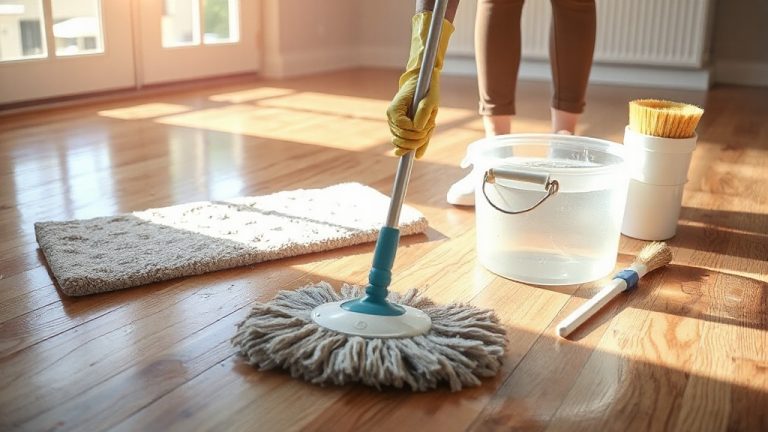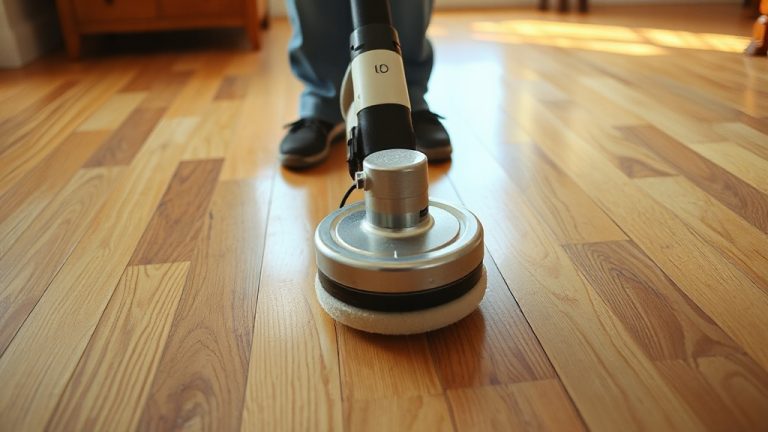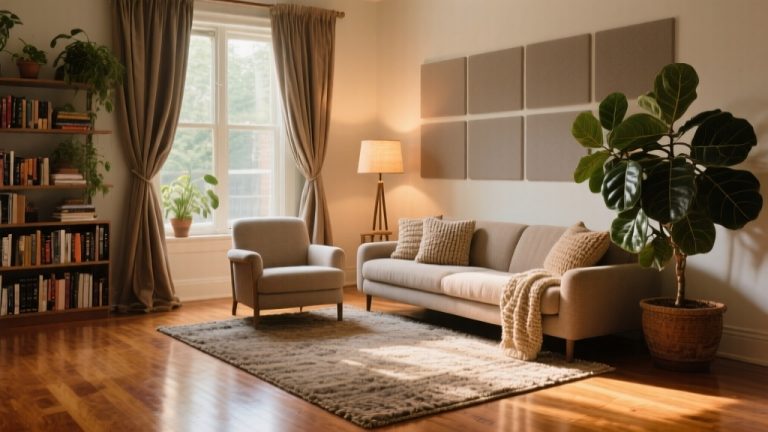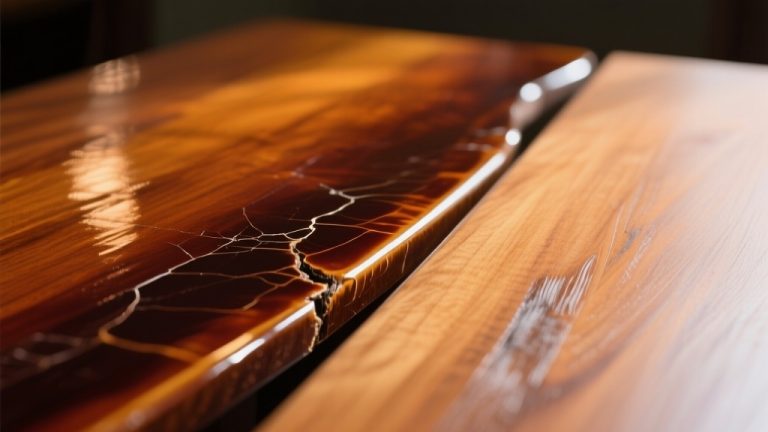How to Clean Sticky Hardwood Floor: 5 Steps [DIY]
Maintaining the appearance and cleanliness of hardwood floors is essential to preserving their beauty and longevity. But sticky residue can accumulate on hardwood floors over time, making them unsightly and difficult to walk on.
This sticky buildup can be caused by various factors, including improper cleaning methods or using the wrong cleaning products. However, you can easily remove the sticky residue by preparing the floors, using commercial cleaners or dish soap and vinegar solutions, then mopping and rinsing.
Today we will discuss effective ways to clean sticky hardwood floors safely and efficiently. We will also explore alternative cleaning methods suitable for different types of wooden floors.
How to Clean Sticky Hardwood Floor – Step-by-Step Guide
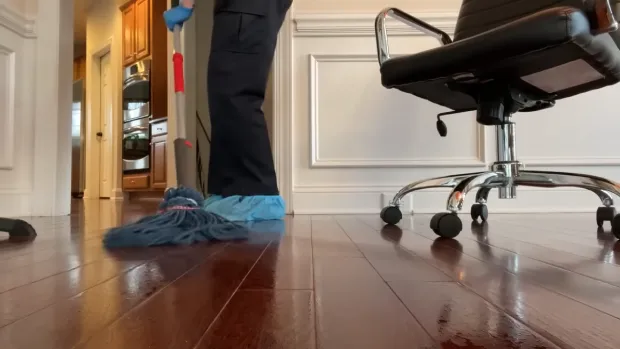
Sticky hardwood floors can be a tedious and frustrating problem to deal with. They look unappealing and attract dirt and grime, making them even harder to clean. You can make your hardwood floors look clean and shiny again by following these simple steps:
Step 1. Gather Your Tools and Materials
Gathering the appropriate tools and materials for this task is necessary to remove unwanted residues.
The primary tool required for cleaning sticky hardwood floors is a sponge, which should have a non-abrasive surface so as not to damage the floor’s finish.
A large bucket or bowl will also be needed to hold warm water mixed with dish detergent. Choosing a suitable detergent that is gentle enough not to harm the wood but strong enough to break down the sticky residue is important.
Warm water helps loosen any dirt and grime on the floor while making it easier for the detergent to penetrate and dissolve the stickiness.
Step 2. Prep Your Floors
Creating a clutter-free and debris-free environment is essential to effectively prepare the surface for removing unwanted residues, as this ensures that no obstructions or items could interfere with the cleaning process.
This step is particularly important when dealing with sticky hardwood floors since any debris can make it difficult to remove the stickiness. Before cleaning, ensure that all toys, clutter, or floor mats are picked up and stored in their respective places.
Vacuum or sweep up any loose dust or dirt from the floor. A vacuum cleaner with a hard floor attachment is ideal for hardwood floors since it can pick up finer particles of dust without scratching the surface.
Once you have cleared your floors of any obstruction and debris, inspect your hardwood floors closely for any stubborn stains that may require additional attention. Depending on the type of stain on your flooring, you may need to use specialized cleaning products such as wood cleaners or vinegar solutions.
After identifying these spots, mark them to tackle them during cleaning. Preparing your floors before cleaning helps ensure an effective result while also preventing further damage to their surface.
Step 3. Prep Your Cleaning Solution

When it comes to cleaning sticky hardwood floors, various solutions can be used. These Includes:
Using Commercial Hardwood Cleaner
Utilizing a commercial hardwood cleaning solution specifically designed for the type of wood flooring in question can effectively maintain its cleanliness and appearance.
As stated in the Background Information, choosing a cleaner with a label that clearly states it is formulated for the specific type of hardwood floor being cleaned is crucial.
Using an appropriate commercial cleaner can help remove sticky residue from hardwood floors without damaging their finish or causing discoloration. These cleaners are typically easy to use and require dilution with water before application.
Using Dish Soap
Mild dish soap mixed with warm water is an alternative for removing residues from wooden surfaces. According to a study, dish soap is one of the most effective cleaners for breaking down dirt and grime.
Using vinegar Solution
A vinegar solution mixed with warm water can potentially remove residues from wooden surfaces. It can clean sticky hardwood floors by mixing 1⁄2 cup of white vinegar with 1 gallon of warm water and scrubbing the sticky area with a soft, non-abrasive cloth.
Vinegar is known for its acidic properties, which help break down dirt and grime, making it an ideal natural cleaning solution for wooden surfaces. However, caution should be taken when using vinegar on hardwood floors, as too much acidity can damage the finish or cause discoloration.
Step 4. Apply the Cleaning Solution
With the application of a specialized solution, the resilient quality of the particular surface is restored to its original state. In cleaning a sticky hardwood floor, applying an effective cleaning solution is vital to remove dirt and grime buildup that causes stickiness.
Before using any solution, it must be tested on a small hidden area first to ensure that it does not damage or discolor the wood. To apply the cleaning solution, follow these simple steps:
- Pour the cleaning solution into a spray bottle for easy application.
- Spray a generous amount of the solution onto a small section of your hardwood floor.
- Allow it to sit for about five minutes before scrubbing it with a soft-bristled brush or mop.
- Repeat this process until you have covered all areas of your floor.
Step 5. Rinse the Floor With Clean Water
After applying the cleaning solution and allowing it to sit for a few minutes, use a damp mop or cloth to wipe away any excess solution. Then, fill a bucket with clean water and dip your mop into it.
Ensure to wring out any excess water from the mop before applying it on the floor. Starting from one end of the room, work towards the other, and rinse every floor section. Change out your water frequently to avoid spreading dirty water across clean areas.
Step 5. Dry the Area Thoroughly
After rinsing the floor with clean water, it’s essential to dry it thoroughly before placing any furniture or walking on it.
Moisture left on the surface may penetrate gaps between boards or beneath them, causing the wood to warp or even rot over time. To make sure you dry your sticky hardwood floors correctly, follow these steps:
- Use a soft towel or mop: Choose a soft and absorbent cloth that won’t scratch your floor surface. Microfiber towels are ideal as they absorb more moisture than traditional cotton towels.
- Remove Excess Water: Gently wipe away water droplets from the wet floor using a towel or dry mop.
- Allow Sufficient Time for Drying: Depending on your home’s humidity levels and how much water was used during cleaning, air drying could take two hours or overnight.
- Do Not Place Furniture Until Fully Dry: Avoid putting furniture back until you’re sure every part of your hardwood floor is entirely dry to prevent further damage.
Alternative Cleaning Methods for Cleaning Sticky Hardwood Floor
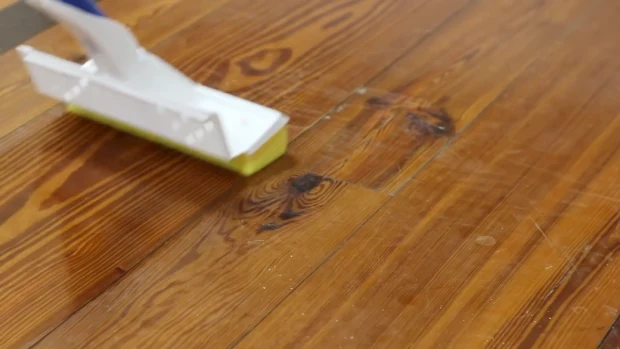
Implementing alternative cleaning methods can effectively address the challenge of removing unwanted residues and substances from a wooden surface that has become tacky. These methods are not only safe but are also cost-effective and readily available.
Shaving Cream
One such method is the use of shaving cream. It works by applying a small amount on the affected area and wiping it off after a few minutes with a damp cloth. Shaving cream leaves no residue, making it an effective solution for sticky hardwood floors.
Mayonnaise
Another alternative cleaning method is mayonnaise, which may seem unconventional but is quite effective. Mayonnaise contains oil and vinegar, which act as solvents to break down sticky residues on the floor’s surface.
It involves applying enough mayonnaise onto the affected area and letting it sit for 10-15 minutes before wiping clean with a damp cloth or paper towel.
Steam Cleaner, Hairdryer, or Heat Gun
Lastly, steam cleaners, hairdryers, or heat guns combined with oil can also remove unwanted stickiness on hardwood surfaces. The heat softens the residue, while oil acts as a lubricant to loosen dirt particles from the floor’s surface.
Afterward, one can use plastic scrapers and pencil erasers to gently scrape off any remaining debris before wiping clean with warm water and soap.
Why Are Your Wood Floors Sticky After Mopping?

Sticky surfaces after mopping may be caused by dirty water or the wrong cleaning solution used. The details are as follows:
Your Water is Dirty
Dirty water can leave sticky residue on your wood floors, especially when you use it to mop hardwood floors without replacing them frequently. The dirt and grime picked up during mopping get transferred back onto the floor when you continue using the same mop water.
Using the Wrong Cleaning Solution
Another reason why your wood floors may feel sticky after mopping could be due to using an inappropriate cleaning solution.
Some cleaning agents contain harsh chemicals that leave a residue on wooden surfaces, making them sticky. Using too much cleaning solution can also lead to a buildup of soap scum on your floor, which makes it sticky.
Safety Tips When Dealing With Sticky Residue on Wood
When dealing with sticky residue on hardwood floors, it is important to consider safety measures. As mentioned in the previous subtopic, the stickiness may be caused by using too much cleaning solution or not rinsing properly after mopping.
However, removing the residue requires more than wiping it off with a damp cloth.
Mind Your Chemical Adhesive Remover
One of the safety tips when cleaning sticky residue on wood is to mind your chemical adhesive remover. Some people resort to using strong chemicals to remove stubborn adhesives, but this can pose health risks if not handled properly.
Always read and follow the instructions carefully before using any chemical remover and wear protective gear such as gloves and a mask.
Don’t Use Too Much Heat:
Another important tip is to avoid using too much heat. Some people use heat guns or hair dryers to soften adhesive residues. However, excessive heat can damage your hardwood floor’s finish or cause warping. Instead, try using warm water and mild detergent for gentle cleaning.
Don’t Use a Metal Blade as a Scraper:
Do not use a metal scrapping blade as a scraper when removing sticky residue from hardwood floors. This can easily scratch or dent the surface of your flooring, which will cost you more time and money for repairs. Use plastic scrapers because they are gentler on hardwood surfaces and less likely to leave marks behind.
What is the best way to clean a sticky floor?
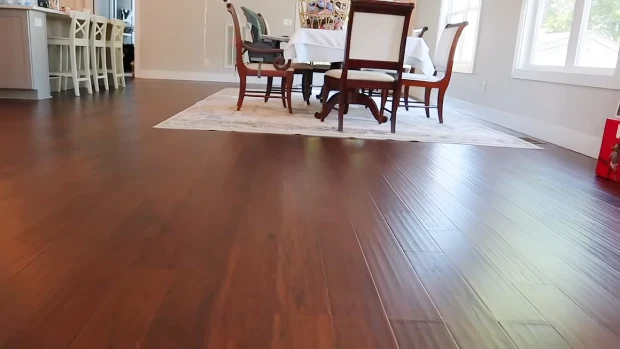
Use the right cleaning method to clean a sticky hardwood floor effectively. The first step in cleaning sticky floors is to sweep or vacuum the surface to remove any loose dirt and debris.
Once this is done, the next step involves using a mop that has been soaked in warm water. Soaking a mop in warm water helps to loosen stubborn dirt and grime from the floor.
To effectively remove excess liquid and dirt from a mop, it is recommended to soak it in warm water and wring it out until dampness is minimal for optimal cleaning.
This ensures that the floor does not get too wet, which can damage its finish or cause warping over time. Work in small sections at a time when mopping, ensuring you rinse your mop regularly. Once you mop, let the floor air dry completely before walking on again.
Will vinegar and water damage hardwood floors when cleaning sticky hardwood floors?
Using vinegar and water as a cleaning solution on wooden surfaces may result in an excess amount of liquid that can lead to swelling and discoloration, potentially compromising the integrity of the wood.
While vinegar is often used as a natural cleaning agent due to its acidic properties, it is important to note that hardwood floors are sensitive to moisture and acidity.
Avoiding excessive amounts of water or vinegar is crucial when cleaning sticky hardwood floors. Over time, continuous use of vinegar and water as a cleaning solution for hardwood floors can cause damage such as dullness or discoloration.
This method may also strip away the protective finish on the wood flooring, leaving it vulnerable to scratches and further damage. Therefore, it is recommended that homeowners with sticky hardwood floors consider other alternatives.
Get Your Hardwood Floors Gleaming with Specialized Cleaners
Maintaining a clean, shiny hardwood floor can be challenging, especially when dealing with sticky residue. However, homeowners can use several effective cleaning methods to restore the beauty of their floors.
These methods include using vinegar and water, dish soap and water, or specialized wood floor cleaners. Safety should always come first when dealing with any cleaning solution or equipment.
Wearing gloves and goggles when handling cleaning agents is a good idea to avoid any potential harm. You’ll be able to keep your floors in good shape for a long time.


